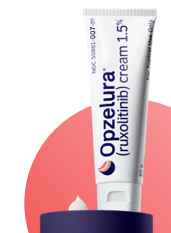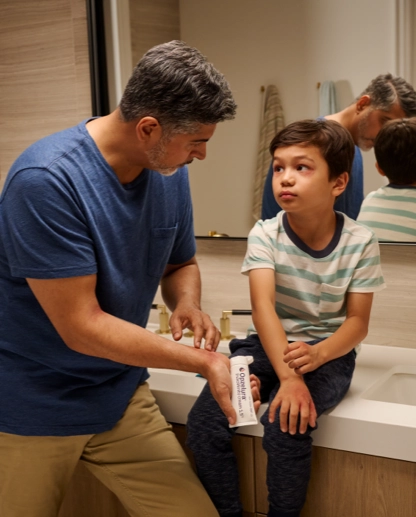MORE THAN 50% OF PATIENTS ACHIEVED CLEAR OR ALMOST CLEAR SKIN (IGA 0/1)
with ≥2-point improvement from baseline‡ at Week 8 (primary endpoint; IGA-TS)
For patients 12+: (53.8% vs. 15.1% and 51.3% vs. 7.6% with vehicle§; P < 0.0001)1,6,7
For patients 2-11: (56.5% vs. 10.8% with vehicle; P < 0.0001)1,8,9
MORE THAN 50% OF PATIENTS 12+ ACHIEVED CLINICALLY MEANINGFUL IMPROVEMENT IN ITCH (NRS4||)
at Week 8 (key secondary endpoint; 52.2% vs. 15.4% and 50.7% vs. 16.3% with vehicle§; P < 0.0001)1,6,7
Difference in Itch NRS4 at Day 2 in patients 12+
POST-HOC, EXPLORATORY ANALYSIS
(NRS ≥ 4; 11.6% vs. 2.9% and 10.8% vs. 1.3%)10,11
No conclusions around efficacy should be made based on these results.
LONG-TERM (52-WEEK) ADVERSE EVENT DATA
Adverse event data from 8 weeks and 52 weeks of application
(8 weeks of continuous BID application plus 44 weeks of as-needed BID application)1,8,12
STUDY DESIGN: OPZELURA was studied in 3 double-blind, randomized, vehicle-controlled trials (TRuE-AD1, TRuE-AD2, and TRuE-AD3). TRuE-AD1 and AD2 were identically designed and included 1249 adult and pediatric patients ≥12 years of age with an affected BSA of 3% to 20% and an IGA score of 2 (25% of patients) to 3 (75% of patients) on a severity scale of 0 to 4. TRuE-AD3 included 330 pediatric patients 2-11 years of age with an affected BSA of 3% to 20% and IGA score of 2 (24% of subjects) to 3 (76% of subjects) on a severity scale of 0 to 4. Patients in all 3 studies were randomized to monotherapy with OPZELURA, ruxolitinib cream 0.75%, or vehicle twice daily for 8 weeks. In a 44-week extension period, patients used their assigned treatment as needed; patients randomized to vehicle were rerandomized to either ruxolitinib cream 0.75% or OPZELURA. Patients were instructed to stop treatment 3 days after lesion clearance and restart at the first sign of recurrence.1,8,9,12
*Postmarketing use since initial approval in September 2021.3
†Across all FDA-approved indications.4,5
‡Measured by IGA-TS, defined as the achievement of clear (IGA 0) or almost clear (IGA 1) skin with at least a 2-point improvement from baseline; IGA is assessed on a severity scale of 0 to 4.1
§In TRuE-AD1 and TRuE-AD2, respectively.1,6
||Itch NRS4 is defined as the achievement of at least a 4-point improvement in daily itch on a 0- to 10-point scale, considered a clinically meaningful response. Patients in the analysis had an NRS score ≥4 at baseline; mean NRS score at baseline was 5.1,6
AD, atopic dermatitis; BID, twice daily; BSA, body surface area; IGA, Investigator’s Global Assessment; IGA-TS, Investigator's Global Assessment treatment success; NRS, numerical rating scale.
“WORTH IT"
An online quantitative survey* was conducted on behalf of Incyte from March 19 to May 10, 2024 including 95 current OPZELURA users ages 12+ with AD.11
According to the 95 AD patients,
98% OF PATIENTS AGREED THAT OPZELURA WAS WORTH THEIR TIME AND EFFORT11
Data were self-reported and outcomes may vary. No conclusions of safety or efficacy should be made based on these results.
Limitations: This survey relied on self-reported data, was not confirmed by a medical professional, and can be affected by bias from selection, recall, response styles, and other sources. Opinions may not be representative of the general population.

*Participants with AD reported they: had received an AD diagnosis; had been using OPZELURA for ≥2 weeks; were current or former users of topical corticosteroids and/or non-steroidal creams.11
The survey covered condition and treatment background, AD disease state, OPZELURA experience, and overall OPZELURA satisfaction.11
AD, atopic dermatitis.


HELP GET PATIENTS STARTED ON OPZELURA






